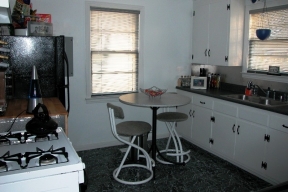Universal Design
Universal design creates environments usable by all people, regardless of ability. Universal design is invisible. It accommodates all people without being an “add on” or designed for people with special needs. Examples of universal design features are step-free entries, curb ramps, levers, wide doorways and handheld adjustable showerheads. Places designed for all ages and abilities are more flexible, efficient and comfortable. Properties with universal design often have higher value and longevity.

Why strive for a universal design?
What are the principles of universal design?
What is difference between universal design and ADA requirements?
How does universal design encourage physical activity?
How does universal design help people age in place?
What are some examples of universal design?
Government partners
Additional resources
Why strive for a universal design?
Universal design will benefit all Tennesseans especially those who are older or have a disability. While accessible design focuses on the needs of the disabled, universal design is a bit broader. Architect Ron Mace used the term “universal design” for products and environments to be usable by all people, to the greatest extent possible, without the need for adaptation or specialized design. Universal design simplifies life making products, communications, and the built environmental more usable by as many people of all ages and all abilities as possible.
What are the principles of universal design?
The Center for Universal Design at North Carolina State University described the following seven principles of universal design on their informative poster:
- Equitable use – the design is useful and marketable to people with diverse abilities
- Flexibility in use – the design accommodates a wide range of individual preferences
- Simple and intuitive – use of the design is easy to understand, regardless of the user’s experience, knowledge, language skills or current concentration level
- Perceptible information – the design communicates necessary information effectively to the user, regardless of ambient conditions or the user’s sensory abilities
- Tolerance for error – the design minimizes hazards and the adverse consequences of accidental or unintended actions
- Low physical effort – the design can be used efficiently and comfortably and with a minimum of fatigue
- Size and space for approach and use – appropriate size and space is provided for approach, reach, manipulation, and use regardless of user’s body size, posture or mobility
What is the difference between universal design and ADA requirements?
ADA requirements are intended to serve people with disabilities, while universal design aims to serve everyone. ADA requirements are regulations that dictate how spaces must be designed to accommodate disabled users, while universal design is an approach where designers think about how a space can accommodate everyone, regardless of age or ability. Universal design can create spaces that are also ADA compliant, but it’s a more holistic design approach than simply meeting ADA requirements.
How does universal design encourage physical activity?
Universal design encourages physical activity by allowing the greatest number of users to access sidewalks, parks, public transit, shops and services. When parks and green spaces are more accessible to more people, they are more likely to use them for exercise and socializing. When public transit, walking and biking infrastructure is safer and more accessible, those active forms of transportation will be used more. When spaces are designed for people with limited means, including ageing users and children, there are more people around at all times of the day, which makes places safer and more inviting for others.
How does universal design help people age in place?
Universal design offers aging users more independence by creating environments where they can function without help from others. This allows people to stay in their homes and neighborhoods as they age, rather than having to move to special needs facilities. Universal design includes not just a home, but sidewalks and transportation options for those who can no longer drive and basic services nearby. One component of universal design, called “visitability,” is where homes have a few basic features to allow for people with limited physical abilities to access a home, including a zero-step entrance, wide clearances in doorways and hallways, and at least a half bath on the first floor of a house.
What are some examples of universal design?
Universal design can be used to benefit many people in many places such as:
- Zero step entrances to buildings
- Handles instead of knobs
- Covered bus shelters with on-demand heating
- Crossing signals that can be both heard and seen
- Curb cuts, ramps, and wide sidewalks for wheelchairs and strollers
- Benches in public places that offer a place to rest
- Directional signs and/or maps with large text to help with wayfinding Protected bike lanes for safety
Government partners
Centers for Disease Control and Prevention (CDC)
Inclusion Strategies
www.cdc.gov/ncbddd/disabilityandhealth/disability-strategies.html#UniversalDesign
Tennessee Commission on Aging and Disability (TCAD)
www.tn.gov/aging.html
Additional resources
North Carolina State University
The Center for Universal Design
www.ncsu.edu/ncsu/design/cud
UniversalDesign.com
www.universaldesign.com
Universal Design Education
www.udeducation.org
Institute for Human Centered Design
www.humancentereddesign.org